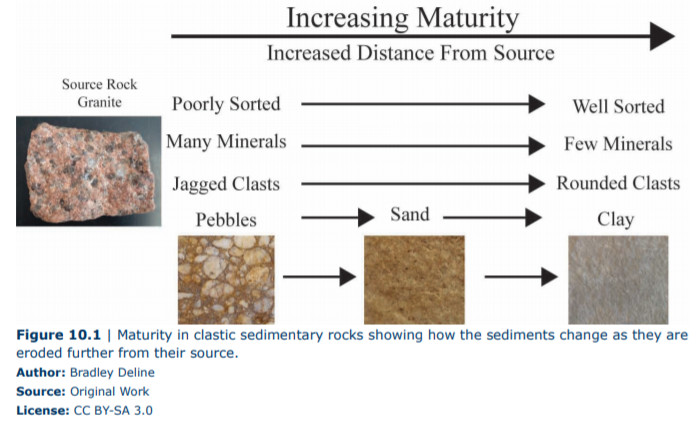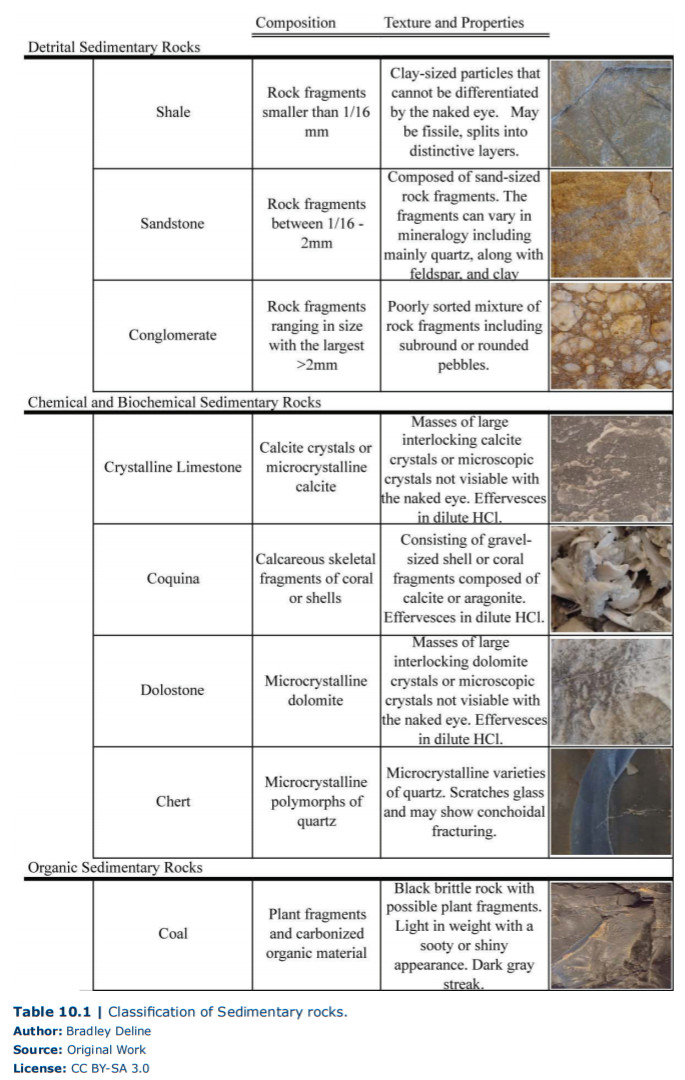Sedimentary rock identification hinges on recognizing clues from weathered and eroded materials. Rockscapes.net can help you discover unique design ideas, different rock types, and installation guidance, transforming your landscape. The key lies in understanding clast maturity, chemical precipitation, and organic accumulation, leading to successful landscape design.
1. Understanding Sedimentary Rock Formation
Sedimentary rocks, a cornerstone of Earth’s crust, are formed through fascinating processes. Understanding their formation is key to identification. These rocks originate from the accumulation and cementation of sediments, which can be fragments of other rocks, minerals, or organic matter. This process, known as lithification, occurs over long periods and under specific environmental conditions. The type of sedimentary rock formed depends on the source material and the depositional environment. According to research from Arizona State University’s School of Earth and Space Exploration, the analysis of sedimentary rock formations provides insights into past climate conditions and geological events.
1.1. What are the Major Types of Sedimentary Rocks?
There are four major types of sedimentary rocks:
- Clastic: Formed from fragments of other rocks and minerals.
- Chemical: Precipitated from solutions.
- Biochemical: Formed from the accumulation of organic matter.
- Organic: Composed of carbon-rich organic remains.
These categories are further divided based on composition, texture, and formation processes. At Rockscapes.net, explore articles detailing how these classifications influence landscape design and material selection.
1.2. How Does Weathering Contribute to Sedimentary Rock Formation?
Weathering is the breakdown of rocks into smaller pieces through physical and chemical processes. This process is the first step in creating sedimentary rocks. Physical weathering breaks rocks into smaller fragments without changing their chemical composition, while chemical weathering alters the minerals within the rocks. According to a study published in the Journal of Sedimentary Petrology, the intensity and type of weathering significantly affect the composition and texture of sedimentary rocks. This makes the weathered material a crucial factor in identifying sedimentary rocks.
 Weathered sandstone rock formation, demonstrating physical weathering
Weathered sandstone rock formation, demonstrating physical weathering
1.3. How Does Erosion Transport Sediments?
Erosion involves the movement of weathered materials from one location to another by agents like water, wind, or ice. The transportation process affects the size, shape, and sorting of sediments. For instance, sediments transported by rivers tend to be rounded and sorted by size, while those transported by glaciers are often angular and poorly sorted. Earth-Science Reviews published a comprehensive analysis in July 2023 on sediment transport mechanisms and their impact on sedimentary rock characteristics.
2. Examining Clastic Sedimentary Rocks
Clastic sedimentary rocks are formed from the accumulation and cementation of mineral and rock fragments (clasts). Identifying these rocks involves analyzing their texture and composition. Grain size, shape, sorting, and mineralogy are key characteristics. These features provide information about the source rock, transport distance, and depositional environment.
2.1. What Are the Key Features of Conglomerates?
Conglomerates are coarse-grained clastic rocks composed of rounded pebbles and gravel cemented together. The rounded clasts indicate significant abrasion during transport. Conglomerates typically form in high-energy environments, such as river channels or alluvial fans. According to the Geological Society of America Bulletin, the composition and size distribution of clasts in conglomerates can reveal the source rock lithology and tectonic history of the area.
2.2. How Do You Identify Sandstone?
Sandstone is a medium-grained clastic rock made of sand-sized grains. The composition of sandstone varies, but quartz and feldspar are common minerals. Sandstones can range from well-sorted and rounded grains (mature) to poorly sorted and angular grains (immature). The degree of sorting and roundness indicates the transport distance and energy of the depositional environment. Rockscapes.net offers detailed guides on using different sandstone types to enhance your landscape design.
 Close-up of sandstone, showing sand-sized grains
Close-up of sandstone, showing sand-sized grains
2.3. What Are the Characteristics of Shale?
Shale is a fine-grained clastic rock composed of clay-sized particles. It’s characterized by its laminated or fissile structure, meaning it splits easily into thin layers. Shales often contain organic matter, which can give them a dark color. They typically form in low-energy environments, such as deep lakes or marine basins. Sedimentary Geology published a study in February 2024 highlighting the importance of shale as a source rock for hydrocarbons.
3. Identifying Chemical Sedimentary Rocks
Chemical sedimentary rocks form through the precipitation of minerals from solution. Evaporation, chemical reactions, and changes in temperature or pressure can trigger this precipitation. The composition of these rocks is primarily determined by the minerals that precipitate.
3.1. How Are Evaporites Formed?
Evaporites are chemical sedimentary rocks that form from the evaporation of water, leaving behind dissolved minerals. Common evaporites include halite (rock salt) and gypsum. These rocks typically form in arid environments, such as salt flats or restricted marine basins. According to the Journal of Sedimentary Research, the sequence of mineral precipitation in evaporite deposits can indicate the chemical evolution of the evaporating water body.
3.2. What Are the Properties of Chert?
Chert is a microcrystalline form of silica (SiO2). It is hard, durable, and has a conchoidal fracture. Chert can form in various environments, including deep-sea sediments and lacustrine settings. It often forms from the accumulation of siliceous skeletons of marine organisms, such as diatoms and radiolarians. The use of chert in landscaping can add unique textures and colors, as highlighted on Rockscapes.net’s design inspiration page.
3.3. How Do You Recognize Limestone?
Limestone is a sedimentary rock primarily composed of calcium carbonate (CaCO3). It can form through both inorganic and biochemical processes. Inorganic limestone precipitates directly from solution, while biochemical limestone forms from the accumulation of shells and skeletons of marine organisms. Limestone is typically white to gray and effervesces (fizzes) when exposed to hydrochloric acid (HCl). The Journal of Geochemical Exploration published an article in November 2023 discussing the use of limestone as an indicator of paleoclimate conditions.
4. Distinguishing Biochemical Sedimentary Rocks
Biochemical sedimentary rocks are formed from the accumulation of organic material, such as shells, skeletons, and plant remains. These rocks often have distinctive textures and compositions that reflect their biological origin.
4.1. What Are the Characteristics of Coquina?
Coquina is a type of limestone composed of poorly cemented shells and shell fragments. It is highly porous and relatively soft. Coquina typically forms in shallow, high-energy marine environments where shell debris accumulates rapidly. Rockscapes.net showcases stunning landscape designs incorporating coquina for a natural, coastal aesthetic.
4.2. How Is Crystalline Limestone Formed?
Crystalline limestone is composed of interlocking crystals of calcite. It forms through the recrystallization of pre-existing limestone, often due to metamorphism or diagenesis. Crystalline limestone is typically harder and less porous than other types of limestone. According to a study in Contributions to Mineralogy and Petrology, the crystal size and texture of crystalline limestone can provide information about the temperature and pressure conditions during recrystallization.
4.3. What Is the Composition of Dolostone?
Dolostone is a sedimentary rock composed primarily of the mineral dolomite (CaMg(CO3)2). It forms through the alteration of limestone by magnesium-rich fluids. Dolostone is similar in appearance to limestone but reacts weakly to hydrochloric acid (HCl), especially if powdered. The American Journal of Science published an extensive analysis in December 2023 on the dolomitization process and its impact on reservoir rock properties.
5. Recognizing Organic Sedimentary Rocks
Organic sedimentary rocks are formed from the accumulation and preservation of organic matter, typically plant remains. These rocks are rich in carbon and often have a dark color.
5.1. How Is Coal Formed?
Coal is an organic sedimentary rock formed from the compaction and heating of plant material over millions of years. It is primarily composed of carbon, along with varying amounts of hydrogen, oxygen, nitrogen, and sulfur. Coal is classified into different ranks (e.g., peat, lignite, bituminous, anthracite) based on its carbon content and energy content. The International Journal of Coal Geology provides cutting-edge research on coal formation, composition, and utilization.
5.2. What Are the Properties of Organic Shale?
Organic shale is a fine-grained sedimentary rock that contains a significant amount of organic matter. The organic matter is typically derived from the remains of algae and other microorganisms. Organic shale can be a source rock for oil and natural gas. The organic content gives the shale a dark color and sometimes a distinctive odor. Rockscapes.net explains the benefits and applications of using organic shale in sustainable landscaping practices.
6. Step-by-Step Guide to Identifying Sedimentary Rocks
Identifying sedimentary rocks involves careful observation and analysis. By following a systematic approach, you can accurately classify these rocks.
6.1. Step 1: Determine the Rock’s Texture
Texture refers to the size, shape, and arrangement of the grains or crystals in the rock. Is the rock composed of visible grains (coarse-grained) or is it fine-grained and smooth? Are the grains rounded or angular? Is the rock layered or massive?
6.2. Step 2: Determine the Rock’s Composition
Composition refers to the minerals or organic materials that make up the rock. Are the grains composed of quartz, feldspar, calcite, or other minerals? Does the rock contain fossils or organic matter?
6.3. Step 3: Test the Rock’s Hardness and Reactivity
Hardness can be tested using a scratch test. Can the rock be scratched with a fingernail, a copper penny, or a steel knife? Reactivity can be tested by applying a drop of dilute hydrochloric acid (HCl) to the rock. Does the rock effervesce (fizz)?
6.4. Step 4: Consider the Rock’s Origin
Origin refers to the environment in which the rock formed. Was the rock formed in a river, a lake, a desert, or an ocean? Understanding the depositional environment can provide valuable clues about the rock’s identity. Rockscapes.net provides insights into how different rock types originate and how to incorporate them into various landscape designs.
7. Tools and Techniques for Sedimentary Rock Identification
To accurately identify sedimentary rocks, several tools and techniques can be used. These methods range from simple visual inspection to advanced laboratory analysis.
7.1. Hand Lens and Magnifying Glass
A hand lens or magnifying glass is useful for examining the texture and composition of sedimentary rocks. It allows you to see individual grains or crystals that may not be visible to the naked eye.
7.2. Dilute Hydrochloric Acid (HCl)
Dilute hydrochloric acid (HCl) is used to test the reactivity of carbonate minerals, such as calcite and dolomite. If a rock effervesces when exposed to HCl, it indicates the presence of carbonate minerals.
7.3. Streak Plate
A streak plate is a piece of unglazed porcelain used to determine the streak color of a mineral. The streak color can be helpful in identifying certain minerals in sedimentary rocks.
7.4. Geological Hammer and Chisel
A geological hammer and chisel are used to break rocks and obtain fresh surfaces for examination. This can reveal the internal texture and composition of the rock.
7.5. Polarizing Microscope
A polarizing microscope is used to examine the optical properties of minerals in thin sections of rock. This technique is commonly used in petrography, the study of rocks under a microscope. According to research from Arizona State University’s School of Earth and Space Exploration, petrographic analysis is essential for detailed identification and characterization of sedimentary rocks.
7.6. X-Ray Diffraction (XRD)
X-ray diffraction (XRD) is a technique used to identify the mineral composition of rocks and sediments. It involves bombarding a sample with X-rays and analyzing the diffraction pattern to determine the crystal structure of the minerals present.
7.7. Scanning Electron Microscopy (SEM)
Scanning electron microscopy (SEM) is a technique used to image the surface of rocks and minerals at high magnification. It can reveal details about the texture, morphology, and composition of sedimentary rocks.
8. Sedimentary Rocks in Landscaping
Sedimentary rocks are widely used in landscaping due to their aesthetic appeal and durability. Different types of sedimentary rocks can be used for various purposes, such as pathways, walls, and decorative features.
8.1. Sandstone for Pathways and Walls
Sandstone is a popular choice for pathways and walls due to its natural colors and textures. It is durable and can withstand weathering and erosion. Sandstone can be used to create a variety of looks, from rustic to contemporary. Rockscapes.net offers a wide range of sandstone products and design ideas to enhance your outdoor spaces.
8.2. Limestone for Garden Features
Limestone is often used for garden features, such as benches, fountains, and sculptures. It has a classic, elegant look that complements a variety of garden styles. Limestone is also relatively soft and easy to carve, making it a versatile material for creating custom designs.
8.3. Shale for Mulch and Ground Cover
Shale can be crushed and used as mulch or ground cover in gardens and landscapes. It helps to retain moisture in the soil, suppress weeds, and add a decorative touch. Shale is also a sustainable and environmentally friendly option.
9. Preserving and Maintaining Sedimentary Rock Features
To ensure the longevity and beauty of sedimentary rock features in your landscape, proper preservation and maintenance are essential. Regular cleaning, sealing, and repair can help to protect these rocks from weathering, erosion, and staining.
9.1. Cleaning Sedimentary Rocks
Sedimentary rocks can be cleaned using a mild detergent and water. Avoid using harsh chemicals or abrasive cleaners, as these can damage the surface of the rock. A soft brush or sponge can be used to remove dirt and debris.
9.2. Sealing Sedimentary Rocks
Sealing sedimentary rocks can help to protect them from staining and weathering. A penetrating sealer is recommended, as it will not change the appearance of the rock. The sealer should be applied according to the manufacturer’s instructions.
9.3. Repairing Sedimentary Rocks
If sedimentary rocks are cracked or damaged, they can be repaired using a stone repair compound. The compound should be applied to the damaged area and allowed to cure. Once cured, the repaired area can be sanded and sealed.
10. FAQ: Identifying Sedimentary Rocks
10.1. What is the main difference between sedimentary, igneous, and metamorphic rocks?
Sedimentary rocks are formed from the accumulation and cementation of sediments, igneous rocks are formed from the cooling and solidification of magma or lava, and metamorphic rocks are formed from the alteration of existing rocks by heat, pressure, or chemical activity.
10.2. How can I tell if a rock is clastic or chemical sedimentary?
Clastic sedimentary rocks are composed of fragments of other rocks and minerals, while chemical sedimentary rocks are formed from the precipitation of minerals from solution.
10.3. What is the significance of fossils in sedimentary rocks?
Fossils in sedimentary rocks provide valuable information about past life, environments, and geological history.
10.4. Can sedimentary rocks be used for construction?
Yes, many sedimentary rocks, such as sandstone and limestone, are used for construction due to their durability and aesthetic appeal.
10.5. How do sedimentary rocks contribute to soil formation?
Sedimentary rocks weather and break down over time, contributing to the formation of soil.
10.6. What role do sedimentary rocks play in the carbon cycle?
Sedimentary rocks, particularly limestone and organic shale, play a significant role in the carbon cycle by storing large amounts of carbon.
10.7. Are sedimentary rocks found on other planets?
Yes, sedimentary rocks have been found on Mars, providing evidence of past water activity and potentially habitable environments.
10.8. How do geologists study sedimentary rocks?
Geologists study sedimentary rocks using a variety of techniques, including field observation, petrography, geochemistry, and geophysics.
10.9. What are some common sedimentary rock formations in the United States?
Some common sedimentary rock formations in the United States include the Grand Canyon (Arizona), the White Cliffs of Dover (Delaware), and the Carlsbad Caverns (New Mexico).
10.10. How does the color of a sedimentary rock help with identification?
The color of a sedimentary rock can provide clues about its composition and origin. For example, red sedimentary rocks often contain iron oxides, while dark sedimentary rocks may contain organic matter.
Ready to explore the world of sedimentary rocks and transform your landscape? Visit rockscapes.net for design ideas, detailed rock information, and expert advice. Contact us at Address: 1151 S Forest Ave, Tempe, AZ 85281, United States. Phone: +1 (480) 965-9011.
